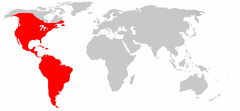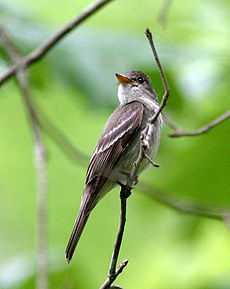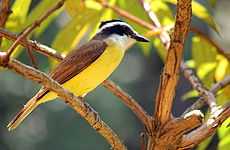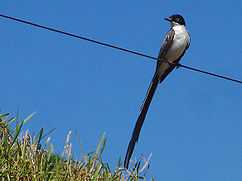Tyrant flycatcher
| Tyrant flycatchers | |
|---|---|
 | |
| Yellowish Flycatcher, Empidonax flavescens | |
| Scientific classification | |
| Kingdom: | Animalia |
| Phylum: | Chordata |
| Class: | Aves |
| Order: | Passeriformes |
| Suborder: | Tyranni |
| Family: | Tyrannidae Vigors, 1825 |
| Genera | |
|
Some 100, see text | |
 | |
| Distribution of tyrant flycatchers | |
The tyrant flycatchers (Tyrannidae) are a clade of passerine birds which occur throughout North and South America. They are considered the largest family of birds on Earth, with more than 400 species. They are the most diverse avian family in every country in the Americas, except for the United States and Canada. As could be expected from a family this large, the members vary greatly in shape, patterns, size and colours. Some Tyrant flycatchers superficially resemble the Old World flycatchers which they are named after but are not related to. They are members of suborder Tyranni (suboscines), which do not have the sophisticated vocal capabilities of most other songbirds.[1]
Most, but not all, species are rather plain, with various hues of brown, gray and white commonplace. Obvious exceptions include the bright red Vermilion Flycatcher and the olive, yellow and grey Ornate Flycatcher. Some species have erectile crests. Several of the large genera (i.e. Elaenia, Myiarchus or Empidonax) are quite difficult to tell apart in the field due to similar plumage and some are best distinguished by their voices. Behaviorally they can vary from species such as spadebills which are tiny, shy and live in dense forest interiors to kingbirds, which are relatively large, bold, inquisitive and often inhabit open areas near human habitations. As the name implies, a great majority of tyrant-flycatchers are entirely insectivorous (though do not necessarily specialized in flies). However, food can vary greatly and some (like the large Great Kiskadee) will eat fruit or small vertebrates (e.g. small frogs). In North America, most species are associated with a "sallying" feeding style, where they fly up to catch an insect directly from their perch and then immediately return to the same perch. Most tropical species however do not feed in this fashion and several types prefer to glean insects from leaves and barks. Tropical species are sometimes found in mixed-species foraging flocks, where various types of passerines and other smallish birds are found feeding in proximity.
The smallest family members are the closely related Short-tailed Pygmy Tyrant and Black-capped Pygmy Tyrant (the first species usually being considered marginally smaller). With a total length of a mere 6.5-6.8 cm (2.5-2.7 in) and a weight of 4-5 grams, they are the smallest passerines on earth. The largest tyrant flycatcher is the Great Shrike-Tyrant at 29 cm (11.5 in) and 99.2 grams (3.5 oz). A few species such as the Streamer-tailed Tyrant, Scissor-tailed Flycatcher and Fork-tailed Flycatcher have a larger total length (up to 41 cm/16 in), but this is mainly due to their extremely long tails.
A number of species previously included in this family are now placed in the family Tityridae (see Systematics). Sibley and Alquist in their 1990 bird taxonomy had the genera Mionectes, Leptopogon, Pseudotriccus, Poecilotriccus, Taenotriccus, Hemitriccus, Todirostrum and Corythopsis as a separate family Pipromorphidae,[2] but although it is still thought that these genera are basal to most of the family, they are not each other’s closest relatives.[2]
Habitat and distribution
Species richness of Tyrannidae, when compared to habitat, is highly variable, although most every land habitat in the Americas has at least some number of these birds. The habitats of tropical lowland evergreen forest and montane evergreen forest have the highest single site species diversity while many habitats including rivers, palm forest, white sand forest, tropical deciduous forest edge, southern temperate forest, southern temperate forest edge, semi-humid/humid montane scrub, and northern temperate grassland have the lowest single species diversity. The variation between the highest and the lowest is extreme; ninety species can be found in the tropical lowland evergreen forests while the number of species that can be found in the habitats listed above typically are in the single digits. This may be due in part to the fewer niches found in certain areas and therefore fewer places for the species to occupy.
Tyrannidae specialization among habitat is very strong in tropical lowland evergreen forests and montane evergreen forests. These habitat types therefore display the greatest specialization. The counts differ by three species (tropical lowland evergreen forests have 49 endemic species and montane evergreen forests have 46 endemic species). It can be assumed that they both have similar levels of specialization.
Regionally, the Atlantic Forest has the highest species richness with the Chocó following closely behind.
Status and conservation
The Northern Beardless Tyrannulet (Camptostoma imberbe) and the Rose-throated Becard (Pachyramphus aglaiae) are protected under the Migratory Bird Treaty Act of 1918.. Both these species are common south of the US border. The situation for a number of other species from South and Central America is far more problematic. In 2007, BirdLife International (and consequently IUCN) considered two species, the Minas Gerais Tyrannulet and Kaempfer's Tody-Tyrant critically endangered. Both are endemic to Brazil. Additional, 7 species were considered endangered and 18 species vulnerable.[3]
Systematics
There are about 400 species in 97 genera. A full list, sortable by common and binomial names is at list of tyrant flycatchers. Species in the genera Tityra, Pachyramphus, Laniocera and Xenopsaris were formerly placed in this family, but evidence suggested they belong in their own family, the Tityridae,[4] where they are now placed by SACC.






- Ornithion (3 species)
- Camptostoma (2 species)
- Phaeomyias - Mouse-colored Tyrannulet
- Nesotriccus - Cocos Flycatcher
- Capsiempis - Yellow Tyrannulet
- Tyrannulus - Yellow-crowned Tyrannulet
- Myiopagis (7 species)
- Pseudelaenia - Grey-and-white Tyrannulet
- Elaenia (18 species)
- Serpophaga (5 species)
- Mionectes (5 species)
- Leptopogon (4 species)
- Pseudotriccus (3 species)
- Phylloscartes (23 species)
- Phyllomyias (14 species)
- Zimmerius (10 species)
- Sublegatus (3 species)
- Suiriri (2 species)
- Mecocerculus (6 species)
- Inezia (4 species)
- Stigmatura (2 species)
- Anairetes - tit-tyrants (8 species)
- Tachuris - Many-colored Rush Tyrant
- Culicivora - Sharp-tailed Grass Tyrant
- Polystictus (2 species)
- Pseudocolopteryx (4 species)
- Euscarthmus (2 species)
- Myiornis (4 species)
- Lophotriccus (4 species)
- Atalotriccus - Pale-eyed Pygmy Tyrant
- Oncostoma (2 species)
- Poecilotriccus (12 species)
- Taeniotriccus - Black-chested Tyrant
- Hemitriccus - typical tody-tyrants (20 species)
- Todirostrum - typical tody-flycatchers (7 species, others now in Poecilotriccus)
- Corythopis - antpipits (2 species)
- Cnipodectes (2 species)
- Ramphotrigon (3 species)
- Rhynchocyclus (4 species)
- Tolmomyias (5 species)
- Platyrinchus - spadebills (7 species)
- Onychorhynchus - Royal Flycatchers (1-4 species, depending on taxonomy)
- Myiotriccus - Ornate Flycatcher
- Myiophobus (6 species)
- Nephelomyias (3 species)
- Terenotriccus - Ruddy-tailed Flycatcher
- Myiobius (5 species)
- Neopipo - Cinnamon Neopipo
- Pyrrhomyias - Cinnamon Flycatcher
- Hirundinea - Cliff Flycatcher
- Cnemotriccus - Fuscous Flycatcher
- Lathrotriccus (2 species)
- Aphanotriccus (2 species)
- Xenotriccus (2 species)
- Mitrephanes (2 species)
- Contopus - pewees (14 species)
- Empidonax (15 species)
- Sayornis - phoebes (3 species)
- Pyrocephalus - Vermilion Flycatcher
- Ochthoeca (9 species)
- Tumbezia - Tumbes Tyrant
- Colorhamphus - Patagonian Tyrant
- Ochthornis - Drab Water Tyrant
- Cnemarchus - Red-rumped Bush Tyrant
- Myiotheretes (4 species)
- Xolmis (8 species, including Heteroxolmis)
- Neoxolmis - Chocolate-vented Tyrant
- Agriornis - shrike-tyrants (5 species)
- Polioxolmis - Rufous-webbed Tyrant
- Muscisaxicola - ground tyrants (13 species)
- Muscigralla - Short-tailed Field Tyrant
- Lessonia (2 species)
- Knipolegus - black tyrants (11 species)
- Hymenops - Spectacled Tyrant
- Fluvicola - typical water tyrants (3 species)
- Arundinicola - White-headed Marsh Tyrant
- Alectrurus (2 species)
- Gubernetes - Streamer-tailed Tyrant
- Satrapa - Yellow-browed Tyrant
- Colonia - Long-tailed Tyrant
- Machetornis - Cattle Tyrant
- Muscipipra - Shear-tailed Gray Tyrant
- Attila - attilas (7-8 species)
- Casiornis (2 species)
- Sirystes - Sirystes
- Rhytipterna (3 species)
- Myiarchus (22 species)
- Deltarhynchus - Flammulated Flycatcher
- Pitangus - kiskadees (2 species, includes Philohydor)
- Megarynchus - Boat-billed Flycatcher
- Myiozetetes (4-5 species)
- Conopias (4 species)
- Myiodynastes (5 species)
- Legatus - Piratic Flycatcher
- Phelpsia - White-bearded Flycatcher
- Empidonomus - Variegated Flycatcher
- Griseotyrannus - Crowned Slaty Flycatcher (formerly in Empidonomus)
- Tyrannopsis - Sulphury Flycatcher
- Tyrannus - kingbirds (13 species)
References
- ↑ del Hoyo, J. Elliott, A. & Christie, D. (editors). (2004) Handbook of the Birds of the World. Volume 9: Cotingas to Pipits and Wagtails. Lynx Edicions. ISBN 84-87334-69-5
- ↑ 2.0 2.1 Rheindt, Frank E., Norman, Janette A. and Christidis, Les; “Phylogenetic relationships of tyrant-flycatchers (Aves: Tyrannidae), with an emphasis on the elaeniine assemblage” in Molecular Phylogenetics and Evolution, September 14, 2007
- ↑ BirdLife International (2007). Species factsheets. Accessed 12 December 2007 available online
- ↑ Adopt the Family Tityridae - South American Classification Committee (2007)
External links
| Wikimedia Commons has media related to Tyrannidae. |
- Tyrant Flycatcher videos on the Internet Bird Collection
-
 Ingersoll, Ernest (1920). "Flycatcher". Encyclopedia Americana.
Ingersoll, Ernest (1920). "Flycatcher". Encyclopedia Americana.